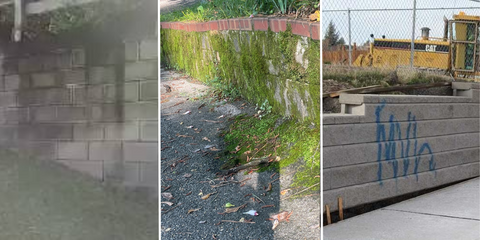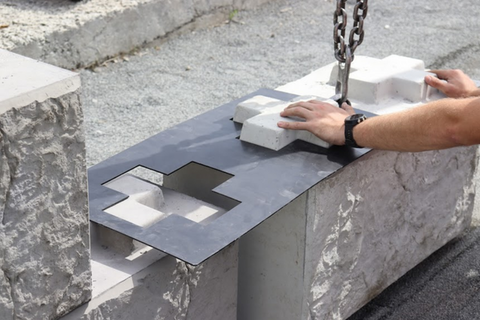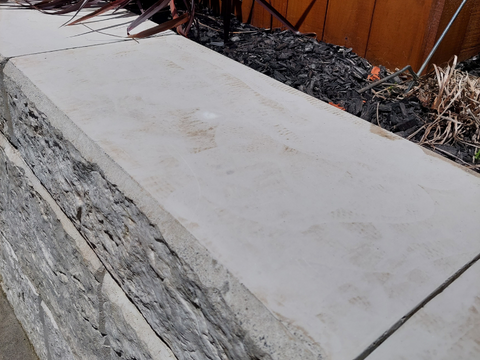Stonebloc retaining walls combine strength and timeless design. To ensure that your wall is looking its best throughout its life, make sure you’re maintaining it. Stonebloc is made to be low maintenance, so it won’t take you much time.
What happens when you don’t keep up with maintenance
If you don’t complete regular maintenance, there could be a number of things that could occur. These are all avoidable if Stonebloc is designed as it should be and regular maintenance is conducted.
- Moss and other buildups on the facia of the wall
- Water leakage
- Graffiti
Here are some examples:

For the easiest maintenance, it starts with the design & installation
Design
Stonebloc is made to be a low-maintenance retaining wall, but there are ways to reduce the time and effort you need to put in. Often, this comes at the design stage of your project - before a single block has been placed.
A waterproof barrier (like a mudguard) can be engineered into the design. Adding this will ensure that unsightly leakage between the blocks is prevented. If you’re considering this for your Stonebloc retaining wall, make sure to take a thicker wall design into consideration at the calculation stage.
Along with a waterproof barrier, it is vital to have good draining with your retaining wall. For Stonebloc designs, we’d recommend a drainage system that allows for a high crush resistance that can be used vertically or horizontally.
Here’s what to consider for retaining wall drainage:
- Getting the right backfill and drain coil for your project is vital. This ensures water/moisture can be effectively drained
- Take into account the type of soil or clay - this may affect the overall design and the maintenance approach after
- Surface water needs to be taken into account. If there are gutter downspits nearby that drain near your wall, divert it away (DIY Retaining Wall)
On its own, Stonebloc is strong with a minimum 20MPa. If you’re needing something stronger, however, you can custom order Stonebloc with a range of specialist blends. This strengthening is done at the production stage when the wet concrete is poured into the Stonebloc mould. The agents that we add to these specialist blocks will help with added durability.
Installation
When installing, use this time to ensure all blocks are aligned correctly. Getting this correct the first time around, means future maintenance is easier.
To get your Stonebloc installation right, watch this video with James:
With installation, you need to ensure you’ve brushed all the blocks of debris. By not brushing away debris, stacked blocks will not sit flush on top of each other. Not only does this cause issues in installation, it also will cause maintenance issues to arise. Chipping of the blocks can occur if installation is not correctly done, and water/moisture drainage can be affected.
One thing you may encounter during installation is block gaps on alternative layers. Stonebloc is not made to be mm precise so they’re quite forgiving during installation. This can be remedied quickly at installation with shims, however, in most cases, these gaps will level out over time. This can still be corrected once the wall is installed, but it can take longer, costing you more money and time as you need to deconstruct the wall.
To help create accurate retaining walls fast, you can use one of our Stonebloc Installation Templates. Getting the base layer of a Stonebloc retaining wall correctly aligned is vital; getting it misaligned will not only make the remaining layers’ installation difficult, it will also lead to inaccuracy. This inaccuracy leads to retaining walls that are harder to maintain over the walls lifetime.

The templates are available in two size
- Single
- Double
Tips for keeping your Stonebloc retaining wall in good condition
ADD GRAFFITI PROTECTION
For walls that are facing the public, it may be worthwhile to consider an anti-graffiti coating. Without adding a coating, graffiti removal from an unprotecting retaining wall can be costly and cause damage to Stonebloc’s facia. This needs to be applied annually
Some of the benefits of using protective coating include:
- Remove graffiti is easily
- No ghosting or shadowing is leftover
- You eliminate the need to hire a professional graffiti removal service as you can do it yourself
- A lot of graffiti protection coatings are also high weather resistance. In many instances, this will protect your Stonebloc wall from UV and salt spray
- The effects of direct and pollution can also be reduced, allowing it to keep it looking the same as when it was first installed
ADD A MOSS GROWTH PREVENTION COATING
If moss occurs, growths can be controlled with a 1: dilution of bleach/water. Just apply over the affected area using a watering can and leave for 2-3 minutes then wash off with a hose and brush. Make sure you use a lot of water to dilute the residue as the bleach will not only kill the moss & algae but other plants as well. It may also change the colour of the block walls. To fully control the spread, you may need to add 2 or 3 applications.
If weeds do appear between the joints of blocks in your Stonebloc wall, they can typically be removed by hand, hot water, steam water blaster, or controlled with weed killer. When using weed killer, make sure it's suitable for retaining walls specifically as it’ll be less likely to stain or discolour the blocks. Always follow the manufacturer’s directions on use and application.
WATER BLAST REGULARLY
Waterblasting is the most effective way to keep Stonebloc clean.
We do not recommend high pressure water blasters as this can damage Stonebloc’s facia, causing an unsightly finish of the wall.
HIDING THE LIFTING PINS
Over time, you may want to hide the lifting pins that sit on top of Stonebloc. This will give you a smooth, polished look. Depending on your project, you could use a cementitious leveling mortar to create an even finish.
Here are the features of a mortar that we’d recommend:
- The ability to apply with thin layers, for easy workability
- Be able to work on materials such as concrete, mortar, and masonry
- Strong, both mechanically and with substrate adhesion
- Good resistance to water & moisture

For any questions about maintaining your Stonebloc wall, reach out to us.









